Properly dried botanicals are vital for mold-free soaps. Herbs and flowers need below 10% moisture content, requiring 1-3 weeks of drying at temperatures under 95°F. Herbal powders must be completely dry, while exfoliants like pumice need longer drying periods than finer additives. Adjust your timing for seasonal conditions—humid climates add 2-3 weeks, while cold weather slows saponification. Mastering these essential drying times will transform your handcrafted soaps from potential disappointments into consistently beautiful creations.
Botanical Soaps: Essential Drying Times For Each Additive
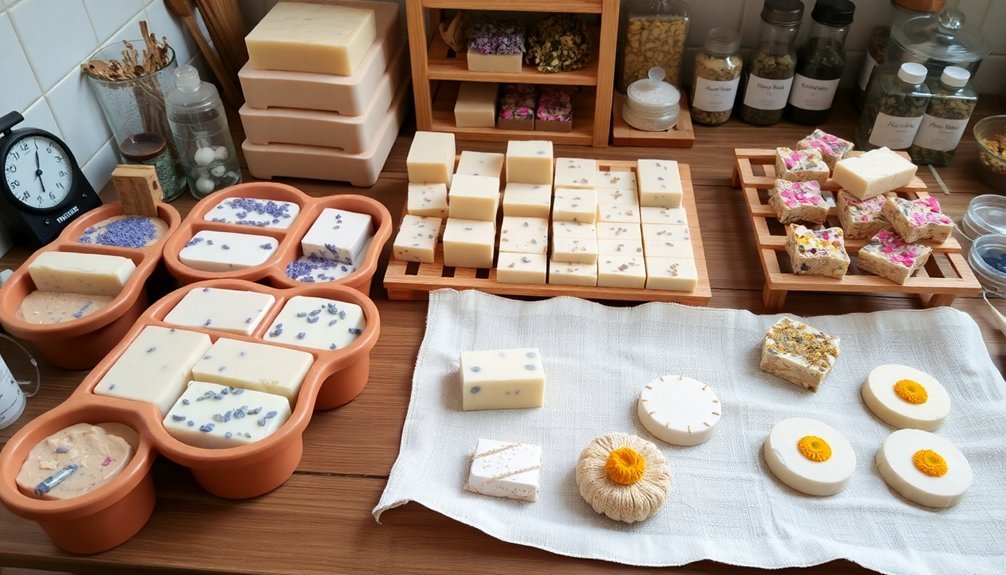
When crafting botanical soaps, understanding the drying characteristics of each additive is essential for achieving perfect results.
You'll need to thoroughly dry all botanical additives before incorporation to prevent moisture-related issues like browning and spoilage.
Herbal powders must be finely milled and moisture-free to avoid texture problems and extended drying times.
Essential oils should be added at trace, where they'll typically integrate within minutes, preserving their aromatic qualities.
Natural colorants and clays greatly impact your soap's curing time. Bentonite clay, for example, absorbs moisture and may extend the drying period, requiring you to adjust your curing schedule accordingly.
Always strain and cool infusions before adding them to your soap mixture—this prevents overheating that could compromise your final product's quality and appearance.
Understanding Drying Requirements for Herb and Flower Additives
When incorporating herbs and flowers into your botanical soaps, you'll need to guarantee they're dried to below 10% moisture content to prevent mold formation and preserve their therapeutic properties.
You can achieve proper drying through air-drying methods or dehydrators, with most botanicals requiring 1-3 weeks depending on their density and environmental conditions.
Storing your dried additives in airtight containers away from light and moisture will extend their shelf life up to a year, maintaining their effectiveness in your soap formulations.
Drying Times Matter
Although many soapmakers focus primarily on recipes and molding techniques, proper drying of botanical additives can make or break your final product.
The drying process typically requires 1-2 weeks, with properly dried herbs reaching a moisture content below 10% to prevent mold growth that compromises your soap's shelf life.
You'll want to maintain temperatures below 95°F (35°C) during drying to preserve the aromatic qualities and beneficial properties of your botanicals.
Guarantee adequate spacing between herbs and flowers for even air circulation.
Once dried, pay attention to storage conditions—cool, dark, airtight containers will maintain botanical potency for soap making.
Remember to limit your herb and flower additions to 5% by weight of your total soap recipe for ideal texture and performance.
These small details greatly impact your finished botanical soaps.
Mold Prevention Basics
Properly dried botanicals serve as the foundation for mold-free soap products that maintain their intended shelf life. You'll need to guarantee your dried herbs and flowers contain less than 10% moisture content to prevent mold development during storage.
After thoroughly drying your botanicals, store them in airtight containers in cool, dark places to protect them from humidity. This extra step maintains quality and extends their usability in your soap formulations.
When incorporating these materials into your soaps, consider their physical properties—larger pieces may trap unwanted moisture.
Regularly inspect your stored botanicals for signs of mold or deterioration, and don't hesitate to discard any compromised materials. This vigilance protects your final products and guarantees your customers receive only the highest quality botanical soaps.
Optimal Drying Times for Popular Exfoliants in Soap Making
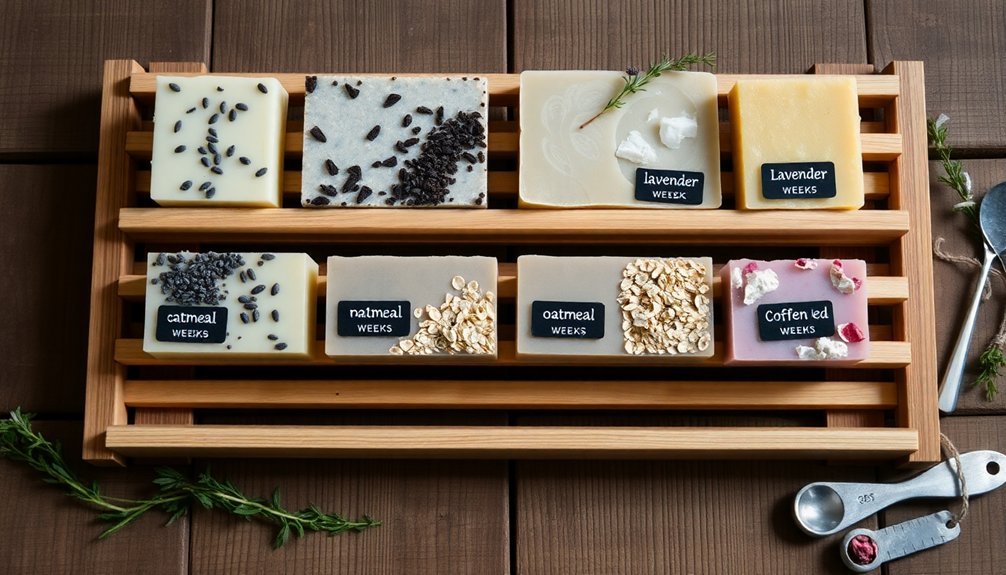
How greatly can your choice of exfoliant affect the drying time of your handcrafted botanical soaps? Considerably, as each natural ingredient introduces unique moisture properties.
Colloidal oats require 1-2 tablespoons per pound of oils but extend drying times due to their inherent moisture content. In contrast, poppy seeds integrate easily with minimal impact on curing time.
Ground pumice demands patience, requiring longer drying periods than gentler exfoliants because of its coarse texture. When using sea salt, limit quantities to 50-100% of your oil weight to prevent excessive moisture attraction and extended drying times.
Remember that particle size matters—finer exfoliants generally dry faster than coarser ones. By understanding these variables, you'll achieve perfectly dried soap bars while still enjoying the benefits of natural exfoliants in your soap making.
The Science Behind Proper Botanical Preparation
When extracting botanical compounds for soap making, you'll need to carefully time the process to maximize beneficial properties while preventing oxidation.
Controlling moisture levels below 10% is essential for preserving phytochemical integrity and preventing microbial growth in your finished soap bars.
Temperature, light exposure, and storage conditions will directly impact the stability of botanical compounds, affecting both the therapeutic properties and shelf life of your handcrafted soaps.
Extraction Timing Matters
The delicate balance between time and extraction makes all the difference in creating exceptional botanical soaps. You'll need patience—cold infusions require days or weeks to capture herbs' subtle properties, while hot infusions work faster but may alter your botanical's characteristics.
When working with dried herbs, steep for at least 24 hours to guarantee effective extraction before soap incorporation. Powdered botanicals need just 30 minutes mixed with oils to properly integrate into your base.
| Botanical Type | Minimum Time | Method | Notes |
|---|---|---|---|
| Dried Herbs | 24 hours | Cold infusion | Preserves delicate aromas |
| Powdered | 30 minutes | Oil mixing | Quick integration |
| Fresh Herbs | 3-7 days | Cold infusion | Longer for full potency |
| Flowers | 1-3 days | Gentle heat | Maintains color vibrancy |
Remember: proper storage in a cool, dry place extends shelf life up to one year, preventing mold issues in your finished soaps.
Moisture Control Fundamentals
Mastering moisture content stands as the cornerstone of successful botanical soap making. When you're preparing your botanicals, you're walking a delicate line—excess water becomes your enemy, leading to mold growth, spoilage, and unsightly discoloration in your finished products.
Your dried botanicals require thorough dehydration to less than 10% moisture content to prevent unwanted chemical reactions and guarantee longevity. Most herbs reach ideal dryness within 1-3 days, depending on humidity and air circulation, while preserving their essential oils.
Before incorporation, use a moisture meter to verify your botanicals meet safe levels. Properly dried additives not only enhance your soap's aesthetic appeal but maintain therapeutic properties.
Once prepared, store them in air tight containers away from light to preserve their color and fragrance integrity.
Phytochemical Stability Variables
Understanding phytochemical stability requires awareness of the complex biochemical dance occurring within your botanical ingredients.
When you're preparing herbs for soaps, remember that temperature, humidity, and light exposure directly impact the potency of active compounds.
To preserve essential phytochemicals, maintain moisture content below 10% during drying to prevent mold growth.
Different botanicals demand specific drying times—delicate herbs like chamomile require quick drying at low temperatures to retain their therapeutic properties.
Choose air drying over oven methods whenever possible, as it better preserves delicate phytochemical structures.
Once dried, store your botanicals in dark, airtight containers to protect them from ultraviolet light, which rapidly degrades these sensitive compounds.
Drying Techniques That Preserve Color and Therapeutic Properties
When preserving the vibrant colors and therapeutic benefits of botanical soaps, your drying technique becomes critically important. Opt for slow air drying in a shaded area to minimize oxidation and heat exposure that can degrade botanical additives. This approach helps maintain both color preservation and beneficial properties.
For faster results without sacrificing quality, use a low-temperature oven or dehydrator set around 95°F (35°C). This temperature range is ideal for retaining essential oils while properly managing moisture retention.
Dark-colored botanicals like hibiscus require immediate low-heat drying to prevent browning and preserve their vibrant hues.
You'll know your botanicals are properly dried when they snap easily when bent—indicating suitable moisture levels that prevent mold while preserving fragrance and therapeutic compounds in your soap formulations.
Seasonal Variations: Adjusting Drying Times for Different Climates
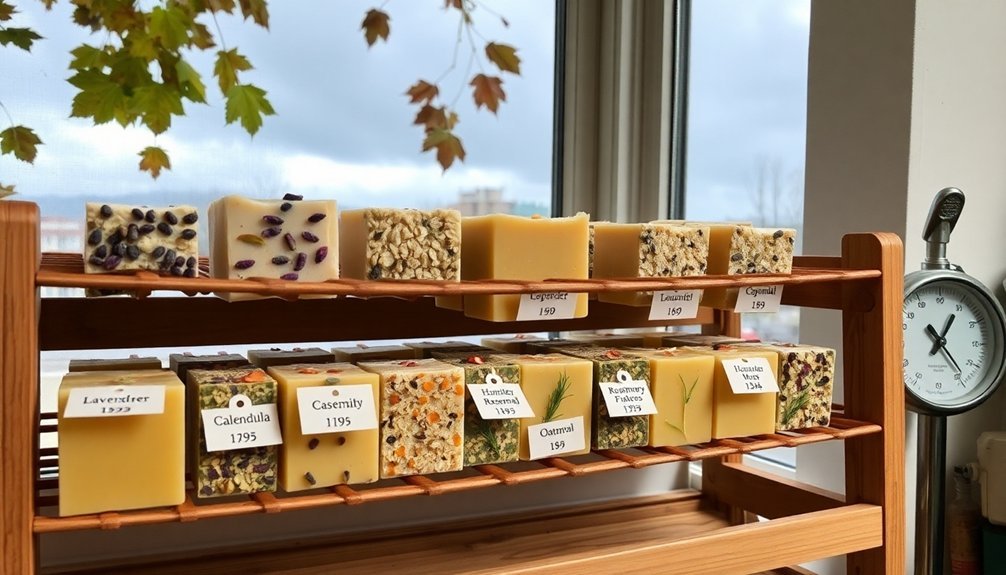
The changing seasons dramatically impact how quickly your botanical soaps will dry and cure properly. In humid climates, expect your botanical soaps to require 2-3 weeks longer than the standard 3-4 week curing period.
Cold weather noticeably slows the saponification process, so you'll need to extend drying times for peak hardness and skin gentleness.
Summer heat presents its own challenges, particularly for honey-infused soaps that risk overheating. Monitor these closely and adjust drying times accordingly.
If you're crafting in regions with significant seasonal changes, consider creating a controlled environment for consistent curing results.
During wetter seasons, place your soaps in well-ventilated areas to prevent moisture retention and potential mold development.
These simple adjustments will guarantee your botanical creations reach their full potential regardless of climate conditions.
Common Mistakes When Drying Natural Soap Additives
Several critical errors can derail your botanical soap-making process before it even begins.
The most prevalent mistake is incorporating herbs that aren't completely dry, leading to moisture retention and eventual spoilage in your finished soap.
Overheating botanicals during drying diminishes their beneficial properties and aromatic qualities.
You'll also compromise quality by neglecting proper storage—always keep dried additives in airtight containers away from light and humidity.
Ignoring recommended drying times for specific herbs (like chamomile's 1-2 week requirement) results in inconsistent scent distribution and texture problems.
When adding improperly dried botanicals to your soap mixture, you'll likely encounter clumping or sinking issues that affect both aesthetics and performance.
Essential Equipment for Properly Drying Botanical Ingredients
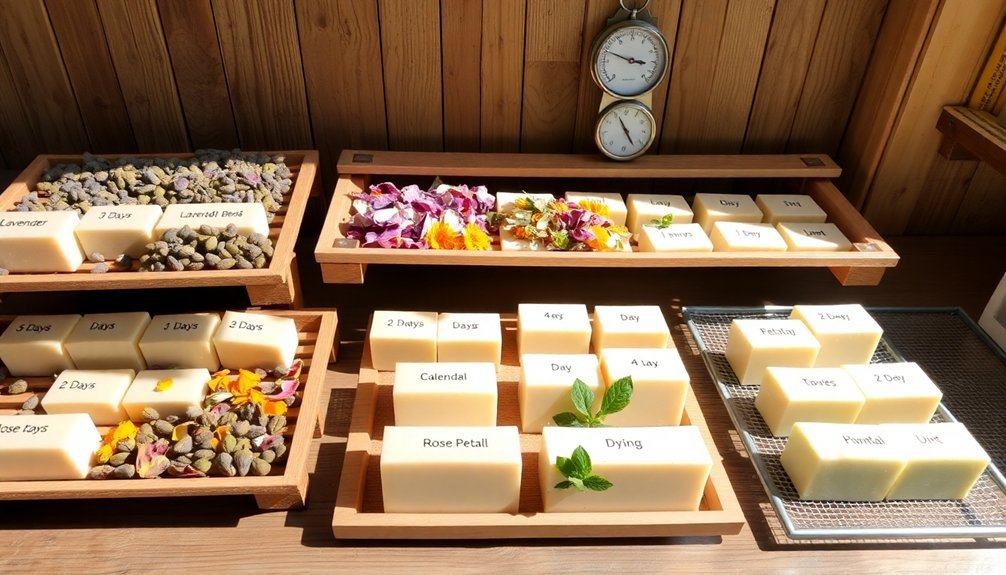
Selecting the right drying equipment makes all the difference between preserving or compromising your botanical ingredients' therapeutic properties. Your dehydrator offers the most control, maintaining ideal temperatures between 95-115°F to retain herbal potency.
| Equipment | Processing Time | Best For |
|---|---|---|
| Dehydrator | 4-8 hours | Most herbs |
| Oven | 1-3 hours | Roots, thick leaves |
| Air Drying | 1-2 weeks | Sturdy stems |
| Microwave | 30-60 seconds | Delicate flowers |
| Solar Dryer | 1-2 days | Leafy herbs |
If you're using an oven, keep the door slightly open to release moisture. For air drying, hang small bunches in a dark, well-ventilated area. Once dried, verify proper storage in airtight containers placed in cool, dark spaces to extend shelf life up to one year.
Frequently Asked Questions
What Is the Minimum Curing Time for Soap?
You'll need to cure your cold process soap for at least 3-4 weeks. While it's safe to use after 48 hours of saponification, proper curing improves hardness, quality, and longevity of your bars.
How Long Does It Take for Soap to Dry?
Your soap will typically dry over 3-4 weeks during the curing process. You'll notice it's ready when it's hardened and excess water has evaporated, though environmental factors like humidity can affect drying time.
Can You Put Too Much Essential Oil in Soap?
Yes, you can put too much essential oil in soap. You'll risk skin irritation, disrupt saponification, and create overpowering scents. It's best to limit essential oils to about 3% of your total soap weight.
How Long Does It Take for Soap Base to Cure?
You'll need to cure cold process soap for 3-4 weeks for peak quality. While it's safe after 48 hours of saponification, proper curing guarantees your bars become harder, longer-lasting, and develop the best texture.
In Summary
You'll find that mastering botanical drying times transforms your soap making results. Each herb, flower, and exfoliant requires specific attention to preserve its benefits. Don't rush this vital step—proper drying prevents mold growth and guarantees vibrant colors. With the right equipment and techniques, you'll create botanical soaps that maintain their therapeutic properties and visual appeal year-round. Your patience during the drying process will reward you with exceptional handcrafted products.

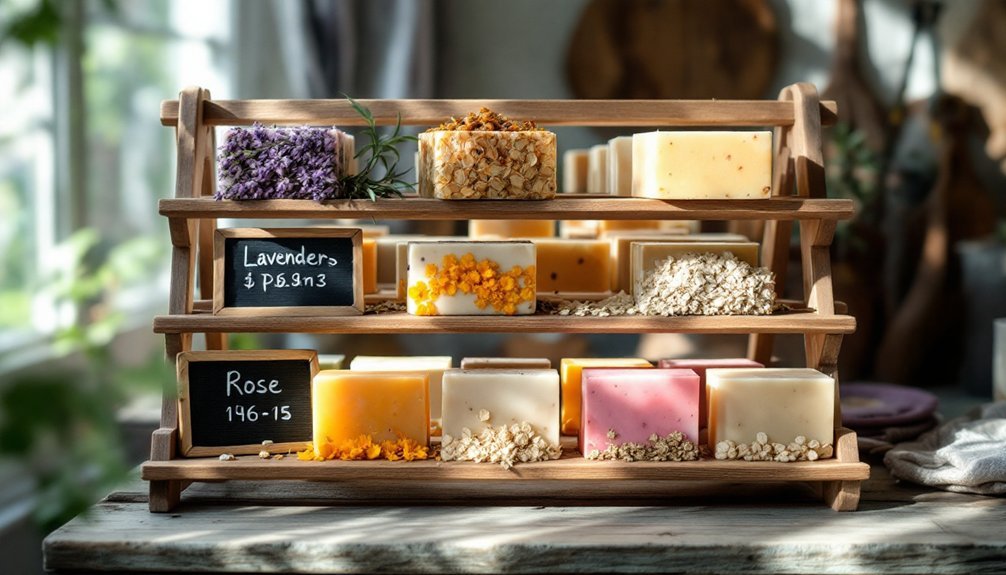



Leave a Reply